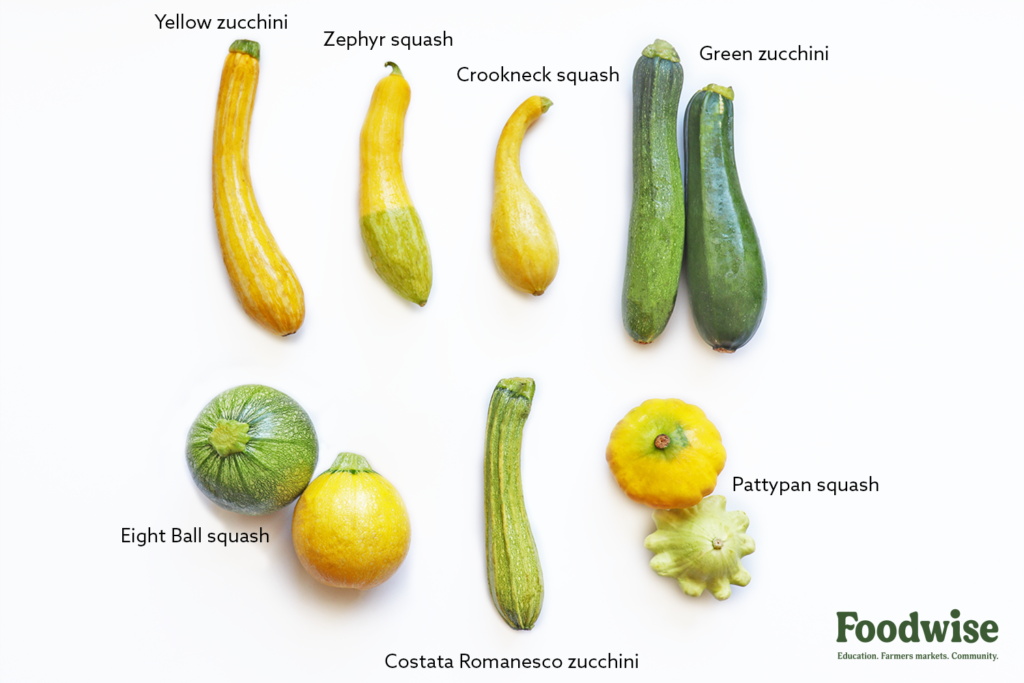Zucchini and Beyond: A Farmers Market Guide to Summer Squash
June 28, 2024

It’s officially summer, which means the explosion of summer squash at the farmers market is just beginning. More than just the common zucchini, summer squash varieties come in different shapes, sizes, and shades of yellow and green, some of which you can only find at the farmers market.
Summer squash are cucurbits (members of the Cucurbitaceae or gourd family), which also includes melons and cucumbers. They are closely related to winter squash, though they are more tender and delicate, with thinner skins and a shorter shelf life. Summer squash are extremely edible, and the soft flesh has a lighter flavor and texture compared to their winter counterparts.
As we enter summer squash season, we’ve collected some common types you’ll cross paths with at the farmers market, along with some flavorful and creative ways to prepare them.

A Field Guide to Summer Squash
Costata Romanesco zucchini: Costata Romanesco is an Italian heirloom variety that is recognizable by its ribbed outer texture (costata means “rib” in Latin). This zucchini has a distinctive medium gray-green color with pale green flecks. It has a soft, thin skin and a nutty flavor.
Crookneck squash: Just like its name, the yellow crookneck squash is usually curved and tapered around the neck, with slightly bumpy skin. Crookneck varieties are believed to be one of the oldest varieties of summer squash. Crookneck squash also contains carotenoids, a plant pigment that contributes to its yellow hue and also acts as an antioxidant.
Eight Ball squash: Eight Ball squash, sometimes known as round zucchini, is very similar to green zucchini with tender skin. These ball-shaped zucchini, which can be found in green or yellow, are generally harvested at one to four inches in diameter. The more petite-sized squash have a sweeter flavor, while the larger sizes are milder in flavor.
Green zucchini: You can find this classic summer squash as early as spring, but it is more flavorful in the summer. The green straightneck zucchini has a deep green color with a smooth skin. It has a mild taste, which means it is extremely versatile and can be eaten raw or cooked.
Pattypan squash: Similar to the Flying Saucer squash, the Pattypan squash is a scalloped variety that resembles a small spinning top. Pattypans come in yellow, green, and white varieties, and are most tender when immature due to their mildly sweet taste.
Yellow zucchini: Similar to the green zucchini in shape, yellow zucchini, or golden zucchini, have a mild taste, which people often say is a bit sweeter than green zucchini.
Zephyr squash: Zephyr is a mild-flavored hybrid crookneck squash that is easily recognizable by its two-tone coloration. The texture is slightly tougher than most summer squash, but the flesh is soft and tender with a mild nutty flavor.

How to Prepare Summer Squash
Because summer squash are so prolific from summer into the fall, it’s good to familiarize yourself with how to buy, store, and cook them. Look for ones that are heavy for their size and have soft, unblemished rinds. Small cuts can lead to quick decay. Also, purchase squash of small or medium size. Larger ones tend to be more fibrous and have larger seeds.
Refrigerate for up to five days. Summer squash are best eaten shortly after harvest, so store them in your refrigerator for up to five days and cook them as soon as possible.
Boil or steam. Boiling or steaming summer squash is the quickest way to tenderize them in just a few minutes. Slice them into a quarter- or half-inch coins, and add them to a saucepan filled with lightly salted boiled water, or on a steamer basket. Cover and steam or boil for a few minutes, and they’re ready to eat!
Roast. This method might take a little more time, but the caramelization from roasting brings out more flavor in the squash. Add your favorite seasoning to the chopped squash before roasting with just a bit of olive oil. Roast in the oven to 425 °F for about 15 minutes, or until lightly browned.
Grill. Grilling takes less time than roasting and also brings out more flavor in summer squash. Cut the squash into quarter- to one-inch pieces; you may want to use skewers. Brush the squash lightly with olive oil and sprinkle with salt and pepper, or with your favorite seasoning. Then grill for 10 minutes, or until the squash is tender, flipping the pieces once.
Bake. For a sweeter fare, you can shred zucchini through a box grater or spiralizer and use them in baked goods such as zucchini bread, cupcakes, and more. Use the Eight Ball or Pattypan squash for stuffed squash if you prefer a savory dish.
Make a casserole. For something different, try a summer squash casserole. You can add multiple kinds of summer squash along with other veggies for a healthy, savory dish.
Make zucchini noodles. For a pasta alternative, cut the zucchini into thin, noodle-like strips through a mandolin, peeler, or spiralizer. Sprinkle salt, and place in a colander to drain for 30 minutes. The salt will help remove the moisture. Enjoy them raw, or pan-fry for 3 to 4 minutes over medium-high heat. Then mix together with your favorite pasta sauce, and enjoy!
Don’t forget about squash blossoms! These bright yellow flowers that come from zucchini plants are commonly used in Latin American cuisine and can be eaten in various ways. Fry them with batter, or stuff them with cheese and bake them in the oven. You can also sauté them quickly and add them to your quesadillas.

Looking for more summer squash inspiration? Dig into the Foodwise recipe archive.
Discover more varieties of summer squash and which farms grow them at Foodwise’s farmers markets here.
Topics: Culinary, Farmers market, Produce guides, Vegetables
